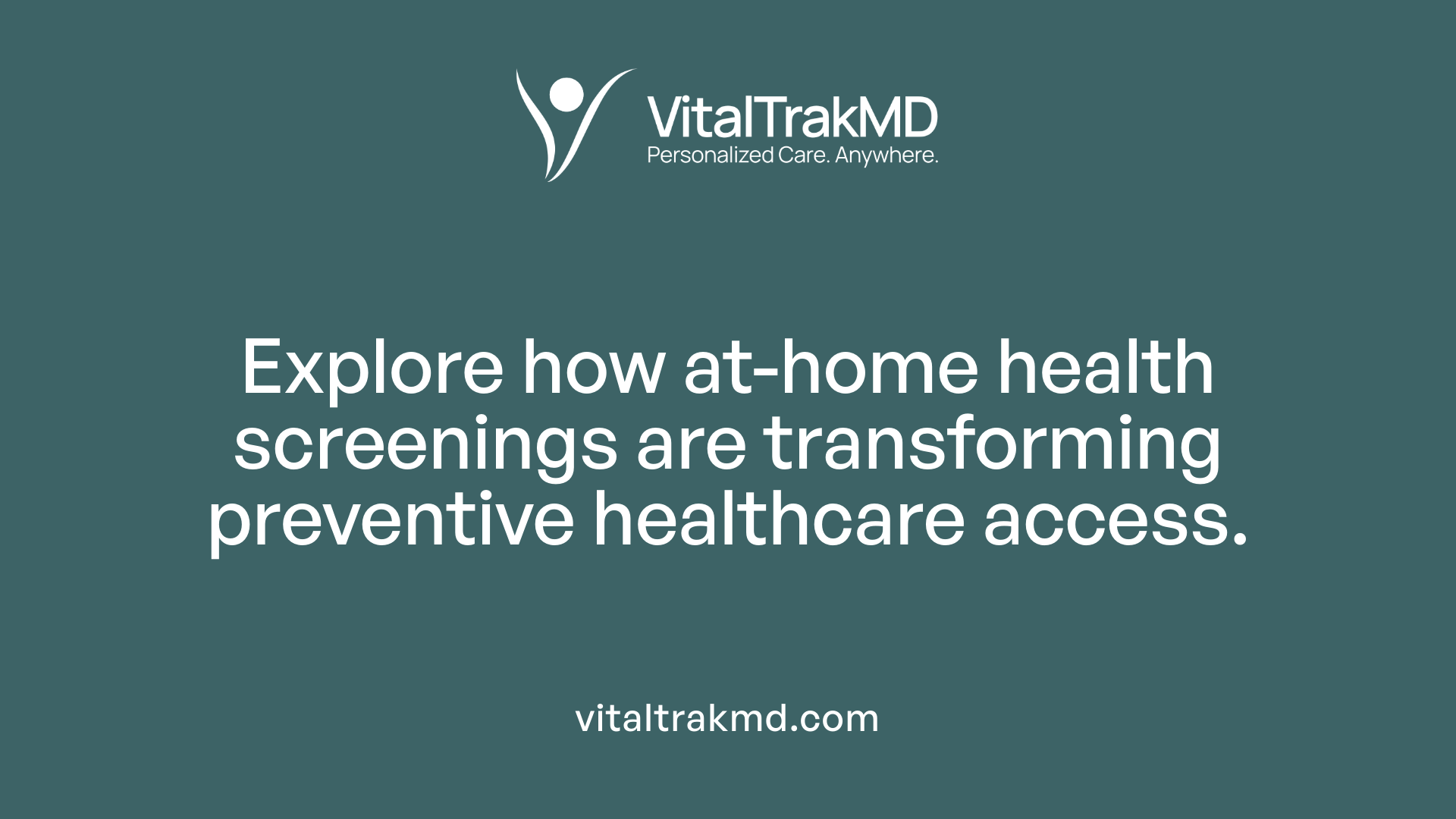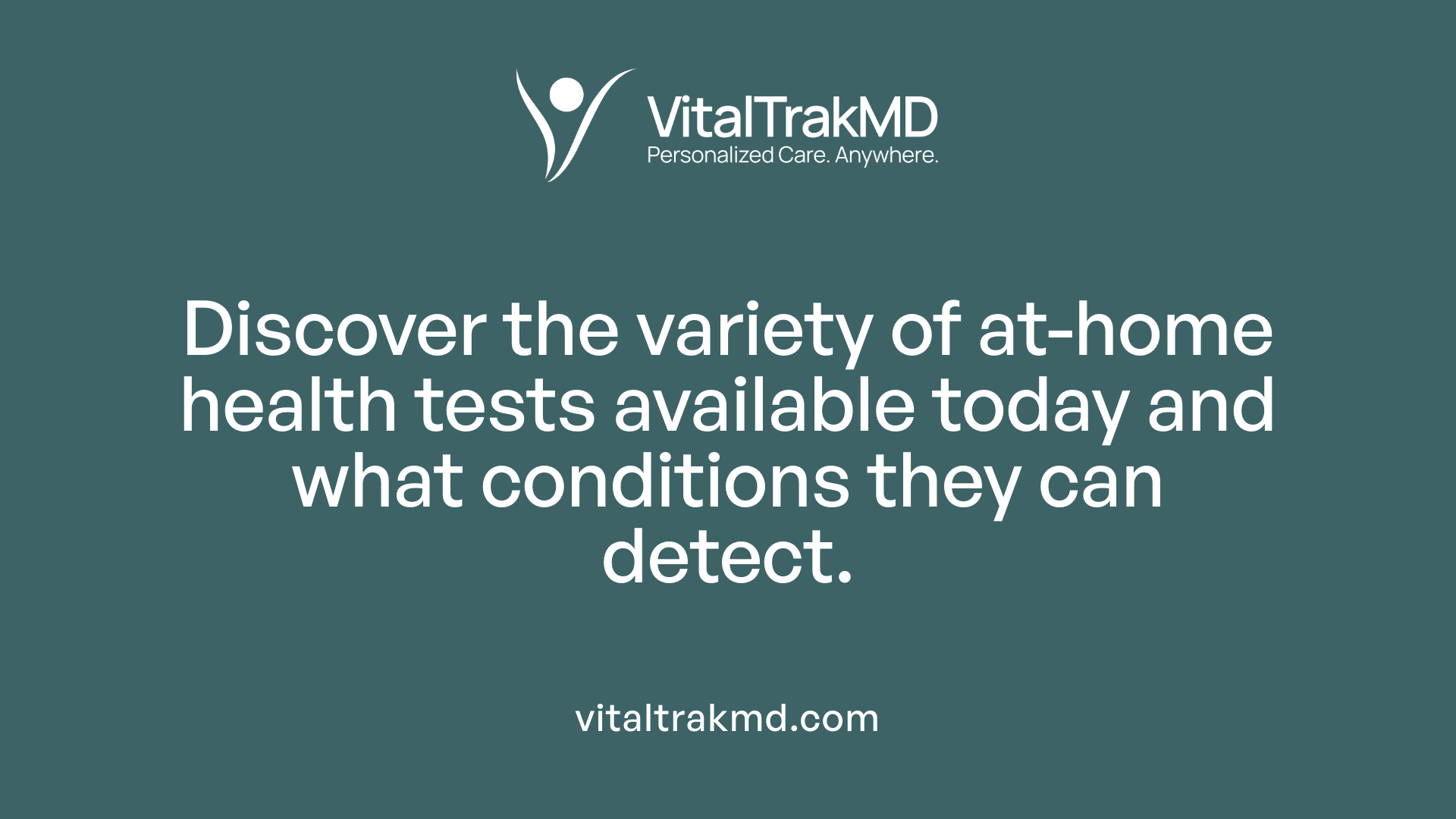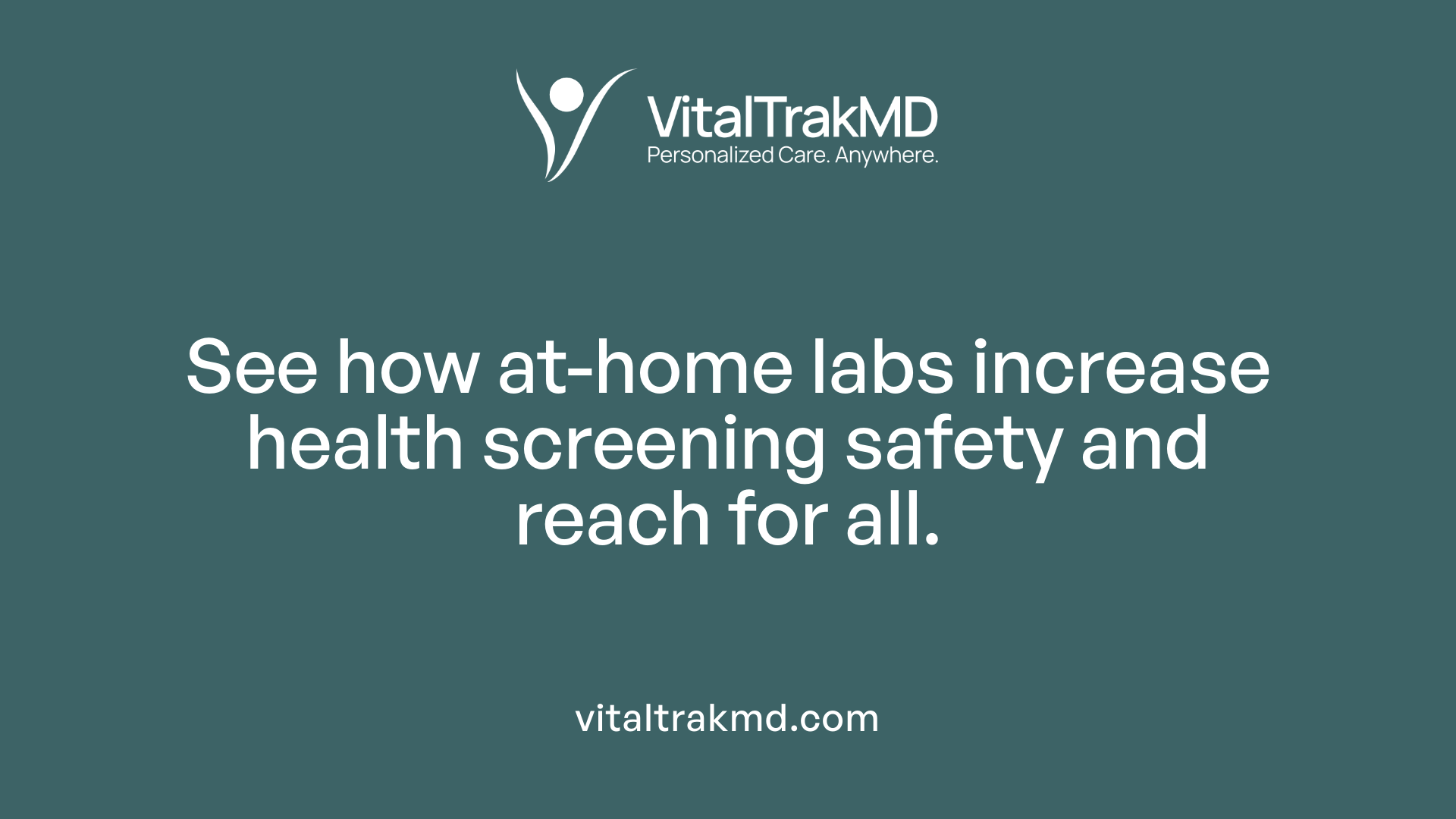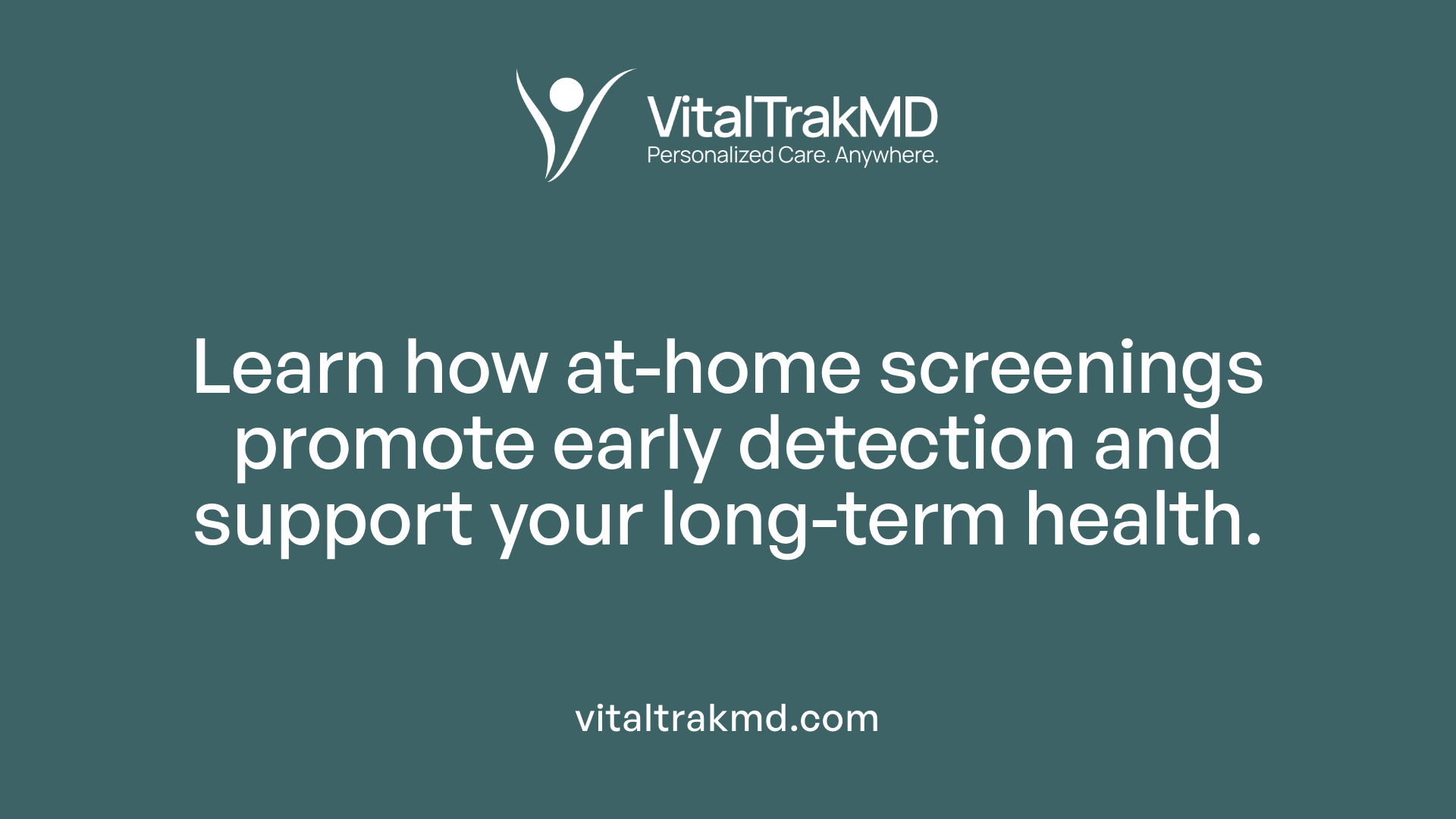Skipping Preventive Screenings? Get At-Home Labs

Rethinking Preventive Screenings in Modern Healthcare
Regular health screenings are essential for early detection and management of many health conditions, including cancers, high blood pressure, cholesterol issues, diabetes, and mental health challenges. Traditional in-clinic screenings, though effective, often pose barriers such as time constraints, access issues, discomfort, and social stigma. As a result, many individuals miss out on crucial early diagnosis. Fortunately, at-home health screening options are transforming preventive care by offering convenient, private, and accessible alternatives that empower individuals to take charge of their health proactively.
The Rise of At-Home Preventive Health Screenings

What are the advantages of at-home preventive health screening options?
At-home preventive health screenings have become an increasingly popular alternative to traditional in-clinic tests, offering numerous benefits to patients. One major advantage is convenience. Patients can perform tests at their own pace and schedule, reducing the need for time-consuming visits to healthcare facilities.
Privacy is another significant benefit. Some individuals may feel embarrassed or uncomfortable during certain procedures, such as cervical or rectal examinations. At-home options allow privacy and comfort, encouraging more people to participate in regular screenings.
Accessibility plays a crucial role, especially for those living in remote areas or with limited mobility. At-home tests eliminate geographical and transportation barriers, making essential health checks more obtainable.
Early detection is facilitated through regular and easy testing. For example, stool DNA tests for colorectal cancer or at-home kits for cervical cancer screening can identify issues before symptoms appear, improving treatment outcomes.
These tests can also save costs and time by reducing the need for clinic visits and associated expenses. Patients can often order testing kits online, perform the test themselves, and receive results digitally.
Empowering individuals to take charge of their health is another benefit. With immediate access to screening tools, people are more likely to monitor their health proactively. However, it remains important for individuals to consult healthcare providers to interpret results and determine next steps.
Overall, at-home health screening options broaden access to vital health checks, promote early diagnosis, and support a more proactive approach to healthcare management.
Traditional In-Clinic Screenings vs. At-Home Testing
How do traditional in-clinic health screenings compare with at-home testing alternatives?
Traditional in-clinic health screenings are carried out by healthcare professionals in a clinical setting. These tests often include blood draws, physical exams, and imaging procedures, providing comprehensive data necessary for accurate diagnosis and immediate interpretation. For example, in-office mammograms or blood tests allow for quick evaluation and follow-up, which is vital for conditions requiring prompt attention.
In contrast, at-home testing options offer significant convenience and privacy advantages. Patients can complete tests like stool DNA tests for colorectal cancer, HPV tests for cervical cancer, or blood spot tests for diabetes at their own pace without visiting a healthcare facility. These methods increase accessibility, particularly for people facing barriers such as transportation issues, busy schedules, or discomfort with traditional screenings.
Research indicates that at-home testing can match the accuracy of in-clinic tests when properly developed and validated. For instance, the Teal Wand cervical cancer screening kit utilizes an FDA-approved primary HPV test with a 96% accuracy rate, providing reliable results from the comfort of home.
Cost-wise, at-home tests tend to be more affordable and eliminate expenses related to healthcare visits. This affordability encourages more frequent screening, especially among at-risk populations or those hesitant to seek in-person care.
However, certain situations still require in-clinic testing. When results are ambiguous, complex, or when immediate medical intervention is necessary, traditional screenings remain indispensable. For example, comprehensive assessment of cardiovascular health or urgent diagnostic procedures must still be conducted in medical facilities.
Both approaches have their strengths, and the optimal strategy often involves integrating at-home testing options with traditional healthcare services to maximize coverage, patient comfort, and early disease detection.
| Aspect | In-Clinic Screenings | At-Home Tests | Key Benefits | Limitations |
|---|---|---|---|---|
| Accuracy | Highly accurate, immediate results | Validated high accuracy, e.g., 96% for HPV | Reliable results | Not suited for complex diagnostics |
| Accessibility | Requires travel, scheduling | Convenient, available nationwide | Increased screening rates | Not suitable for all conditions |
| Cost | Generally higher | Affordable, insurance billing | Cost-effective | Limited scope for some tests |
| Patient Comfort | Can be uncomfortable or invasive | Comfortable, private | Higher patient satisfaction | Not feasible for all tests |
| Emergency Situations | Essential for urgent care | Limited or none | Immediate medical support | Not appropriate for emergencies |
This comparison highlights how at-home testing complements traditional screenings by improving convenience and access, while in-clinic tests provide depth and immediacy when necessary.
Available At-Home Screening Tests and Their Applications
 Many health screenings can now be performed conveniently at home, making it easier to detect potential health issues early. For example, cervical cancer screening is available through at-home HPV testing kits, such as the FDA-approved Teal Wand, which allows women aged 25-65 to collect a sample at home without discomfort and mail it to a lab for analysis.
Many health screenings can now be performed conveniently at home, making it easier to detect potential health issues early. For example, cervical cancer screening is available through at-home HPV testing kits, such as the FDA-approved Teal Wand, which allows women aged 25-65 to collect a sample at home without discomfort and mail it to a lab for analysis.
Beyond cervical cancer, there are numerous other at-home tests for common health concerns. Cholesterol levels can be checked via blood tests, while blood glucose tests help monitor diabetes. Stool DNA tests are widely used for colorectal cancer screening, providing a safe alternative to in-office procedures—especially beneficial for those with busy schedules or access issues. Urine tests are effective for early detection of kidney disease, particularly in people with diabetes.
Similarly, sexually transmitted infection (STI) testing kits are available, enabling individuals to collect samples such as swabs or urine without visiting a clinic. These samples are then sent to laboratories like Labcorp or Quest, which partner with companies like Getlabs to facilitate sample collection at home.
These services typically involve collecting blood, stool, urine, or swab samples, which are then analyzed in certified labs. Results are usually shared with patients through secure digital portals, often integrated with apps like Apple Health, combined with virtual consultations when needed.
Several companies provide these convenient testing options, offering simple and affordable pricing, with insurance billing as usual. They prioritize comfort and accessibility, helping to reduce barriers linked to traditional screenings.
Below is a summary example of common at-home tests, their methods, and target conditions:
| Test Type | Sample Collection Method | Target Condition | Notes |
|---|---|---|---|
| HPV (Cervical Cancer) | Self-collected vaginal swab | Cervical cancer | FDA-approved, high accuracy |
| Cholesterol | Blood sample via finger prick | Heart disease | Usually performed quarterly or annually |
| Blood Glucose | Finger prick blood sample | Diabetes monitoring | Two or more times yearly |
| Stool DNA (Colorectal Cancer) | Stool sample | Colon cancer | Annual screening recommended |
| Urine test (KED) | Urine sample | Kidney disease | Particularly in diabetics |
| STI testing | Urine or swab samples | Various infections | Confidential and private |
Overall, these innovations in at-home testing are making health monitoring more accessible, comfortable, and efficient, supporting early diagnosis and better health outcomes.
Enhancing Accessibility and Safety with At-Home Labs
 At-home laboratory testing options are revolutionizing how people access health screenings, offering numerous benefits for diverse populations. They are particularly valuable for those living in rural areas, individuals with mobility challenges, or busy professionals who find it difficult to visit clinics and labs regularly.
At-home laboratory testing options are revolutionizing how people access health screenings, offering numerous benefits for diverse populations. They are particularly valuable for those living in rural areas, individuals with mobility challenges, or busy professionals who find it difficult to visit clinics and labs regularly.
These solutions make necessary health tests more accessible by eliminating the need for travel, long wait times, and appointment scheduling. For example, services like Getlabs bring mobile phlebotomists right to a person’s home or office, ensuring that even those in remote locations can receive diagnostic tests such as blood work or cholesterol panels.
Safety is another crucial advantage, especially in times of infectious disease outbreaks. At-home testing significantly reduces the risk of exposure to illnesses like COVID-19 by limiting in-person visits to healthcare facilities. Patients can perform initial screenings privately, maintaining social distancing and minimizing contact with potentially infected individuals.
During health crises, such as the COVID-19 pandemic, the role of at-home tests becomes even more vital. They enable continuous health monitoring without risking virus exposure, helping detect issues early despite disruptions in traditional healthcare services.
These tests are not only convenient but also foster a sense of control over personal health. They allow users to screen for conditions like colorectal cancer or diabetes efficiently, often providing quick results through digital platforms or healthcare providers. By simplifying the process and reducing barriers, at-home labs empower individuals to stay proactive in managing their health and can lead to earlier diagnoses and interventions.
While at-home testing enhances access and safety, it is important that results are interpreted correctly with the help of healthcare professionals. Follow-up consultations ensure proper treatment and health management, making these tools effective complements to traditional healthcare.
Limitations and Considerations in Using At-Home Tests
 At-home health testing kits have become increasingly popular, offering convenience and privacy for early detection of various health conditions. They empower individuals to take an active role in their health management, especially in remote or underserved areas where access to healthcare facilities may be limited. These kits can be used for screening for issues like colorectal cancer, kidney disease, or diabetes, often with straightforward procedures and quick results.
At-home health testing kits have become increasingly popular, offering convenience and privacy for early detection of various health conditions. They empower individuals to take an active role in their health management, especially in remote or underserved areas where access to healthcare facilities may be limited. These kits can be used for screening for issues like colorectal cancer, kidney disease, or diabetes, often with straightforward procedures and quick results.
However, despite their benefits, there are important limitations to consider. One concern is the accuracy of at-home tests. Not all kits meet the same regulatory standards, and some may produce false positive or false negative results. Inaccurate results can lead to unnecessary anxiety or, conversely, a false sense of security, delaying essential medical treatment.
Another risk involves the potential for misinterpretation of results or improper sample collection and handling. Users may not follow instructions precisely, which can invalidate the test or produce unreliable data. Without proper training or guidance from healthcare providers, these errors can compromise the test's effectiveness.
Moreover, at-home tests are not a substitute for professional medical advice. Confirmatory testing and proper diagnosis often require a healthcare provider’s assessment, interpretation of results, and follow-up care. Relying solely on self-administered tests without medical consultation can lead to missed diagnoses or inadequate treatment.
In summary, while at-home testing kits are a valuable addition to healthcare options, they have limitations related to accuracy, user errors, and the need for professional follow-up. Patients should verify the credibility of these kits, follow instructions carefully, and consult healthcare professionals to understand their results and determine appropriate next steps.
| Aspect | Consideration | Impact |
|---|---|---|
| Accuracy | Variable regulatory standards | False positives/negatives affecting diagnosis |
| User errors | Improper sample handling | Invalid results, misinterpretation |
| Medical follow-up | Need for professional guidance | Ensures accurate diagnosis and treatment |
Using at-home tests judiciously with awareness of their limitations helps ensure they support, rather than hinder, effective healthcare management.
The Role of At-Home Tests in Early Detection and Preventive Care
How do at-home tests work, and what role do they play in early health detection?
At-home tests allow individuals to collect samples of bodily fluids such as blood, saliva, urine, or stool in the comfort of their own homes. These samples are then either analyzed immediately with easy-to-use kits or sent to laboratories for detailed testing. This process makes health screening accessible and convenient.
For example, stool DNA tests for colorectal cancer enable people to screen for signs of cancer without visiting a clinic, especially if results are normal. Similarly, at-home kits like the Teal Wand for cervical cancer screening provide a simple way to detect HPV – a major risk factor for cervical cancer – through virtual consultations, sample collection, and online result delivery.
The role of these tests in early detection is increasingly vital. They help identify high-risk conditions like cancers, infections, and chronic illnesses before symptoms appear, often leading to earlier and more effective treatment.
At-home testing supports those with limited access to healthcare facilities, individuals with busy schedules, or those uncomfortable with traditional exams. However, the accuracy of at-home tests can vary depending on the type and how correctly samples are collected.
This underscores the importance of following all instructions carefully and consulting healthcare providers for proper interpretation of results. While at-home tests help in proactive health management, they are best used to supplement regular medical checkups, ensuring comprehensive care.
Overall, at-home testing empowers people to take control of their health, promoting early diagnosis of serious conditions and supporting preventive health measures.
The Significance of Preventive Screenings and How At-Home Options Enhance Them
 Preventive health screenings play a vital role in maintaining long-term health by catching diseases early, often before symptoms even appear. The benefits are especially clear in conditions like cancer, diabetes, high blood pressure, and high cholesterol, where early diagnosis can significantly improve treatment outcomes and increase survival rates.
Preventive health screenings play a vital role in maintaining long-term health by catching diseases early, often before symptoms even appear. The benefits are especially clear in conditions like cancer, diabetes, high blood pressure, and high cholesterol, where early diagnosis can significantly improve treatment outcomes and increase survival rates.
For example, screenings such as mammograms for breast cancer, colon cancer stool DNA tests, and blood pressure checks are essential routines recommended at different ages or based on individual risks. Catching issues early means treatment can be less invasive, more effective, and can help prevent serious health complications.
Self-monitoring tools are increasingly contributing to preventive care. At-home kits like the FDA-approved Teal Wand for cervical cancer or testing services from providers like Getlabs make routine screenings more accessible and less intimidating. These innovations allow people to collect samples at home and consult healthcare providers virtually, reducing barriers such as time, discomfort, and access challenges.
Many at-home tests, including urine-based kidney disease tests (KED), A1C blood sugar tests for diabetes, and stool DNA tests for colorectal cancer, are safe, convenient, and accurate. They help individuals stay on top of their health in a private and comfortable setting, encouraging consistent screening habits.
The shift toward at-home testing and virtual healthcare expands routine screening beyond traditional healthcare settings. It supports early detection, which is crucial for effective disease management. By making screenings easier and more routine, at-home options promote a culture of proactive health, helping to identify health issues sooner and reduce long-term risks.
In summary, preventive screenings save lives by enabling early diagnosis. When combined with at-home testing options, they increase accessibility, convenience, and comfort, ultimately empowering individuals to take an active role in their health and well-being.
Empowering Preventive Care Through At-Home Testing
As healthcare continues to evolve, integrating at-home testing options into routine preventive care offers a promising pathway to improve health outcomes. These tools are particularly valuable in increasing access, enhancing safety, and encouraging proactive health management. While they are not replacements for comprehensive in-clinic evaluations, at-home tests serve as vital supplements, ensuring that more people can participate in regular screenings, detect conditions early, and seek timely treatment. By embracing these innovative solutions, individuals and healthcare systems alike can work towards a healthier, more accessible future, where preventive care is personalized, convenient, and effective.
References
- Don't Hit Pause on Health Screenings
- Getlabs: At-Home Lab Visits Near You for Labcorp & Quest
- Many women skip their cervical cancer screenings. Is an at ...
- Don't Hit the Pause on Health Screenings
- Preventive Health Screening — At Home!
- At-Home Medical Tests
- At-Home Health Tests and How They Work
- Home self-testing kits: helpful or harmful? - PMC
- At-home tests: Help or hindrance?
- Home self-testing kits: helpful or harmful? - PMC
Recent articles
Want to Feel Better and Live Healthier?
Join hundreds of patients taking control of their health with personalized care that fits their life – not the other way around.
Rated 4.8/5 by 32+ customers







